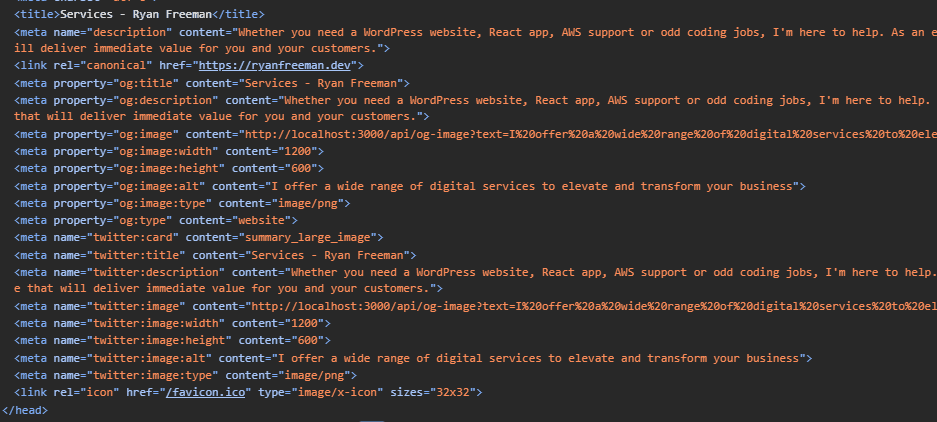Generating dynamic Open Graph images with Next.js
· — views
In this post I'll talk about how I created dynamic, eye-catching Open Graph images with Next.js for this website.
What is Open Graph?
Open Graph is the web standard that allows website owners to manage the appearance of their content when it is shared on social media platforms.
In other words, it enables website owners to attract readers to their content, similar to how thumbnails on YouTube videos attract our attention and entice us to click on a video.
Show me the code
Alright, let's see how this was achieved in code. Taking the new Services page as an example, the first step was to create a new API route located at /api/og-image.
API route
This API route should allow me to specify some text like a page heading and dynamically generate an image, which I can then reference using the Open Graph meta tags on each page.
export async function GET(request: Request) { const { searchParams } = new URL(request.url) const text = searchParams.get('text')
This was straightforward to implement, here the API route responds to a GET request and accepts a text parameter in the url. For example, /api/og-image?text=hello,world.
return new ImageResponse( ( <div style={{ fontSize: 64, background: 'black', width: '100%', height: '100%', display: 'flex', textAlign: 'center', alignItems: 'center', justifyContent: 'center', lineHeight: '1', padding: '0 128px' }} > <div style={{ backgroundImage: 'radial-gradient(at right top, rgb(221, 214, 254), rgb(239, 68, 68), rgb(251, 146, 60))', backgroundClip: 'text', // @ts-ignore '-webkit-background-clip': 'text', color: 'transparent' }}> {text} </div> </div> ), { width: 1200, height: 600 } )
Next, I thought about how I wanted the Open Graph image to look. To keep things simple, I settled on a black background with the text centered both horizontally and vertically.
This was achieved using the ImageReponse constructor, which allows you to create and style dynamic images using JSX and CSS.
When you visit the API route and specify some text in the url, you'll get something that looks like the image above. Next, I'll demonstrate how I added the Open Graph meta tags to the Services page to render this dynamic image for social media platforms.
Open Graph Meta Tags
The last step was to include the Open Graph meta tags on the Services page so that when it's shared, an eye-catching image will appear to draw readers to the content.
const meta = { title: 'Services - Ryan Freeman', heading: 'I offer a wide range of digital services to elevate and transform your business', description: 'Whether you need a WordPress website, React app, AWS support or odd coding jobs, I\'m here to help. ' + 'As an experienced software engineer, I produce high-quality software that will deliver immediate value for you and your customers.', } export const metadata = { ...meta, openGraph: { title: meta.title, description: meta.description, images: [ { url: `/api/og-image?text=${meta.heading}`, width: 1200, height: 600, alt: meta.heading, type: 'image/png' } ], type: 'website' } }
By exporting the metadata object, I was able to specify the Open Graph meta tags for this page. In this example, you can see how I’m fetching data from the new API route, which generates a dynamic image featuring the page heading, sized at 1200 by 600 pixels.

Lastly, I can verify everything is working correctly by loading the Services page in the browser and examining the Open Graph meta tags.
Conclusion
In this post, I demonstrated how you can create dynamic Open Graph images with Next.js for creating content previews which engage readers and attract them to your content.